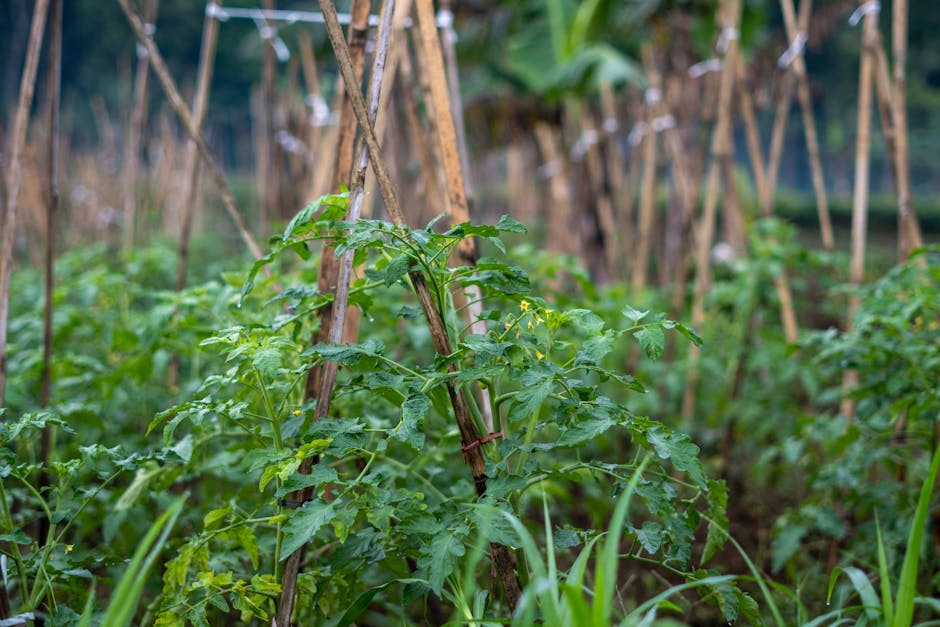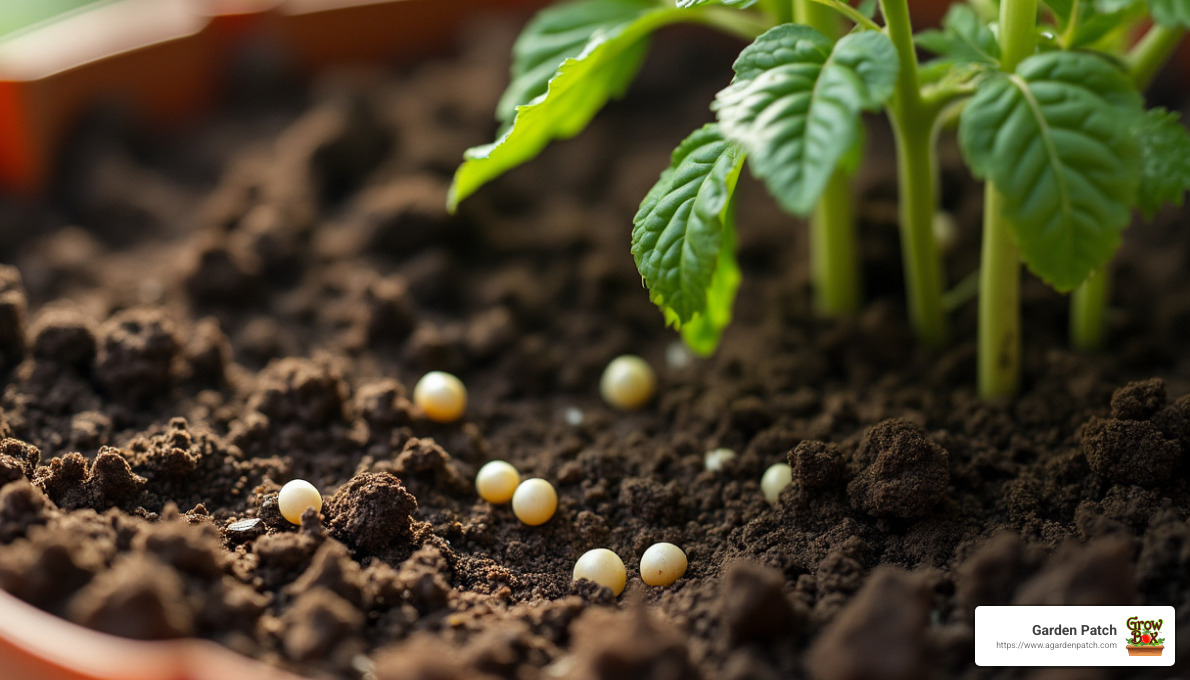Tomato plant soil pH is key to growing delicious tomatoes right in your backyard. A slightly acidic pH range of 6.2 to 6.8 is best for tomatoes, allowing them to absorb the nutrients they need. Proper pH is crucial for healthy growth and flavorful fruit.
Tomatoes are a favorite among home gardeners not just for their juicy taste, but also for their versatility in the kitchen. Whether you want to slice them up for sandwiches, toss them in a salad, or cook them into sauce, homegrown tomatoes offer a flavor that store-bought ones just can’t match. Knowing how to achieve the right Tomato plant soil pH can make all the difference in your harvest.
I’m Bill Vandeven. As a seasoned expert in Tomato plant soil pH, I’ve spent years researching effective gardening techniques. My passion is empowering home gardeners to achieve high yields with less effort.

Importance of Soil pH for Tomato Plants
The Tomato plant soil pH is more than just a number—it’s the secret ingredient to a thriving garden. The right pH level helps your tomatoes absorb nutrients, grow healthy, and produce delicious fruit. Let’s explore why this matters so much.
The Perfect pH Range
For tomatoes, a slightly acidic soil pH between 6.2 and 6.8 is ideal. This range allows the roots to take in essential nutrients like phosphorus, which is crucial for DNA, energy production, and photosynthesis. When the pH is just right, your plants can easily access these nutrients, leading to vibrant growth and bountiful harvests.
Nutrient Uptake
Imagine laying out a feast for your tomato plants but they can’t eat it. That’s what happens if the soil pH isn’t right. At low pH levels, nutrients like phosphorus get locked up with iron and aluminum, making them unavailable to your plants. Conversely, a high pH can bind nutrients with calcium and magnesium, causing the same issue. The sweet spot between 6 and 7 is where nutrients are most available, ensuring your tomatoes get all they need to thrive.

Plant Health
Healthy plants are happy plants! When tomatoes grow in soil with the right pH, they are less likely to suffer from nutrient deficiencies that can stunt growth or cause discolored leaves. A balanced pH supports strong roots, lush foliage, and ultimately, delicious tomatoes. Ensuring your soil pH is within the ideal range is like giving your plants a multivitamin—it’s a simple step that makes a big difference.
The pH scale is logarithmic, so even a small change can have a big impact. A pH of 6 is ten times more acidic than a pH of 7, which means adjustments should be made carefully.
In the next section, we’ll explore how to test and adjust your soil pH to keep your tomatoes thriving.
How to Test and Adjust Tomato Plant Soil pH
Testing and adjusting the Tomato plant soil pH is a straightforward process that can make a world of difference for your garden. With the right tools and knowledge, you can ensure your tomatoes grow in the perfect environment. Let’s break it down.
Testing Soil pH
Before you can adjust anything, you need to know where you stand. Testing your soil pH is the first step, and it’s simpler than you might think.
-
Soil Test Kits: These kits are available at most garden centers and are easy to use. They typically include a solution and a color-coded guide. Mix a small amount of soil with the solution, and the resulting color will indicate your soil’s pH. It’s a quick and affordable way to get a snapshot of your soil’s condition.
-
pH Meters: For a more precise reading, consider using a digital pH meter. Just insert the probe into the soil, and you’ll have an instant pH reading on the screen. This method is great for gardeners who want to monitor their soil regularly.
-
Local Extension Services: If you want a detailed analysis, local agricultural extension services can provide a comprehensive soil test. They can offer insights into nutrient levels and other factors affecting your soil’s health. This option might take a bit longer, but it’s invaluable for serious gardeners.

Adjusting Soil pH
Once you know your soil’s pH, it’s time to make adjustments if needed. Here’s how you can do it:
-
Organic Matter: Adding organic matter like compost can help balance soil pH over time. It improves soil structure and provides a slow, steady release of nutrients. Plus, it’s great for the environment!
-
Peat Moss: If your soil is too alkaline, peat moss is a fantastic amendment. It lowers pH levels and improves soil texture, making it easier for roots to grow. Mix it into the top layer of your soil for the best results.
-
Lime: For soils that are too acidic, lime is your go-to amendment. It raises the pH and adds calcium and magnesium, which are essential for plant health. Be sure to use the right type of lime—dolomitic lime is great if your soil also needs magnesium, while calcitic lime is best if it doesn’t.
Adjusting pH is a gradual process. Make changes slowly and retest your soil to ensure you’re moving in the right direction.
In the next section, we’ll discuss the ideal conditions for tomato plant soil pH and why they matter so much for your garden’s success.
Tomato Plant Soil pH: Ideal Conditions
When it comes to growing tomatoes, the Tomato plant soil pH is a crucial factor that can make or break your harvest. The ideal pH range for tomato plants is slightly acidic, between 6.2 and 6.8. This range isn’t just a random number; it plays a pivotal role in how well your plants can absorb essential nutrients.
Why 6.2 to 6.8 is Ideal
A soil pH of 6.2 to 6.8 creates the optimal environment for nutrient availability. In this range, key nutrients like phosphorus, nitrogen, and potassium are most accessible to tomato roots. This means your plants can efficiently take in the nutrients they need to grow strong and healthy.
-
Nutrient Availability: In slightly acidic soil, nutrients dissolve more easily, making them readily available for absorption. This is crucial for robust plant growth and fruit production.
-
Phosphorus Uptake: Phosphorus, vital for energy transfer and photosynthesis, is best absorbed in this pH range. Outside of it, phosphorus can become locked up in the soil, unavailable to your plants.
-
Calcium and Magnesium: These nutrients, essential for plant structure and enzyme function, are also more soluble in slightly acidic conditions. Ensuring they are available helps prevent common issues like blossom end rot.
The Role of Slight Acidity
Slightly acidic soil not only boosts nutrient uptake but also fosters beneficial microbial activity. These microbes help break down organic matter, releasing nutrients and improving soil health.
-
Microbial Activity: Beneficial microbes thrive in this environment, aiding in nutrient breakdown and improving soil structure. This creates a healthier, more vibrant garden.
-
Preventing Nutrient Deficiencies: By maintaining the proper pH, you reduce the risk of deficiencies that can stunt growth and reduce yield.
Keeping your soil within this sweet spot ensures your tomatoes have everything they need to thrive. If your soil’s pH is off, don’t worry! Adjustments can be made with the right amendments, as we discussed earlier.
Next, we’ll explore common soil pH issues and practical solutions to keep your tomato plants thriving all season long.
Common Soil pH Issues and Solutions
Tomato plants are picky about their soil pH. If it’s too high or too low, they struggle to get the nutrients they need. Let’s explore how you can tackle these issues for a bountiful harvest.
High pH Solutions
When soil pH is too high (alkaline), essential nutrients like iron and zinc become insoluble. This means your plants can’t absorb them, leading to poor growth and yellow leaves.
Here’s how to fix high pH:
-
Sulfur Amendments: Adding sulfur, like aluminum sulfate or garden sulfur, can help lower the pH. This makes nutrients more available to your plants. For example, in clay soils, you might need about 50 pounds of sulfur per 1,000 square feet to drop the pH from 8.0 to 6.5.
-
Organic Matter: Incorporate organic materials like peat moss or compost. These not only help lower pH but also improve soil structure and water retention.
Low pH Solutions
If your soil is too acidic (low pH), it can also cause problems. Nutrients like calcium and magnesium become less available, leading to issues like blossom end rot.
Here’s how to raise low pH:
-
Lime Application: Adding lime is a common way to increase soil pH. Crushed limestone or dolomite lime can do the trick. For example, raising the pH from 5.0 to 6.5 in sandy loam might require about 85 pounds of limestone per 1,000 square feet.
-
Calcium and Magnesium: Dolomite lime not only raises pH but also adds calcium and magnesium. These nutrients are crucial for strong cell walls and preventing deficiencies.
Tackling Nutrient Deficiencies
Even with the right pH, your plants might show signs of nutrient deficiencies. Here’s what to look out for and how to address them:
-
Nitrogen Deficiency: Look for pale green or yellow leaves. Use a nitrogen-rich fertilizer to boost growth.
-
Magnesium Deficiency: Leaves may show yellowing between veins. Epsom salt can help replenish magnesium levels.
-
Phosphorus Deficiency: Dark, purplish leaves indicate a lack of phosphorus. Bone meal or rock phosphate can help.
By keeping an eye on your soil’s pH and adjusting it with the right amendments, you can ensure your tomato plants have the nutrients they need to thrive.
Next, we’ll tackle some frequently asked questions about tomato plant soil pH and how to optimize your garden for a successful harvest.
Frequently Asked Questions about Tomato Plant Soil pH
How to make soil more acidic for tomato plants?
Tomato plants love slightly acidic soil. If your soil’s pH is too high, you can make it more acidic using a few simple methods:
-
Organic Matter: Adding organic matter is a natural way to lower soil pH. Compost or well-rotted manure can do wonders. They not only acidify the soil but also enrich it with nutrients.
-
Peat Moss: This is another excellent choice. Peat moss is naturally acidic and can help bring down the pH while improving soil structure and moisture retention.
-
Sulfur: As mentioned earlier, sulfur is effective in lowering soil pH. It’s a bit more aggressive than organic matter, so use it carefully.
Do tomato plants like coffee grounds?
Yes, they do! Coffee grounds are a fantastic addition to your tomato garden. They are slightly acidic and rich in nutrients like nitrogen, which tomato plants love.
-
Nutrient-Rich: Coffee grounds are packed with nitrogen, which is essential for leafy growth. Just sprinkle them around your plants or mix them into the soil.
-
Composting: If you have a compost pile, toss in your coffee grounds. They break down quickly and add valuable nutrients to your compost, which you can later use to enrich your garden soil.
Is a pH of 7 too high for tomatoes?
A pH of 7 is on the higher end of the acceptable range for tomatoes. While it’s not ideal, it’s not the end of the world either. Tomatoes prefer a slightly acidic environment, ideally between 6.2 and 6.8, but they can still manage at a pH of 7.
- Slight Adjustments: If you’re aiming for optimal growth, consider making slight adjustments. Adding a bit of organic matter or a touch of peat moss can help nudge the pH down into the sweet spot for tomatoes.
Keeping your soil’s pH in check is crucial for a thriving tomato garden. With a few tweaks, you can create the perfect environment for your plants to flourish.
Up next, we’ll explore how the Garden Patch™ GrowBox™ can make gardening a breeze, ensuring you get the most out of your tomato plants with minimal effort!
Conclusion
Gardening should be fun, not a guessing game. That’s where the Garden Patch™ GrowBox™ comes in! Our system makes growing tomatoes easy, even if you’re just starting out. With the GrowBox, you get more than just a planter; you get a fool-proof gardening solution designed to maximize your tomato yields with minimal effort.
Here’s what makes the GrowBox so special:
-
Self-Watering and Self-Fertilizing: Say goodbye to the hassle of daily watering and fertilizing. The GrowBox takes care of it for you, ensuring your tomato plants receive just the right amount of water and nutrients they need to thrive.
-
High Yields, Less Work: Our patented Nutrient Patch™ system delivers consistent nutrition, leading to bigger, juicier tomatoes. You’ll enjoy a bountiful harvest without the back-breaking labor.
-
Perfect for Any Space: Whether you have a sprawling yard or a small balcony, the GrowBox fits perfectly. It’s ideal for urban dwellers, busy families, and anyone who wants fresh tomatoes without the fuss.
-
Easy Soil pH Management: The GrowBox helps maintain the ideal soil pH for tomato plants, between 6.2 and 6.8, ensuring optimal nutrient uptake and plant health.
With the Garden Patch™ GrowBox™, you’ll enjoy gardening success like never before. It’s time to experience the joy of homegrown tomatoes without the usual challenges. Join our community of happy GrowBox gardeners and start your effortless gardening journey today!
For more tips and tricks on tomato plant care, visit our care page and find how easy gardening can be!




